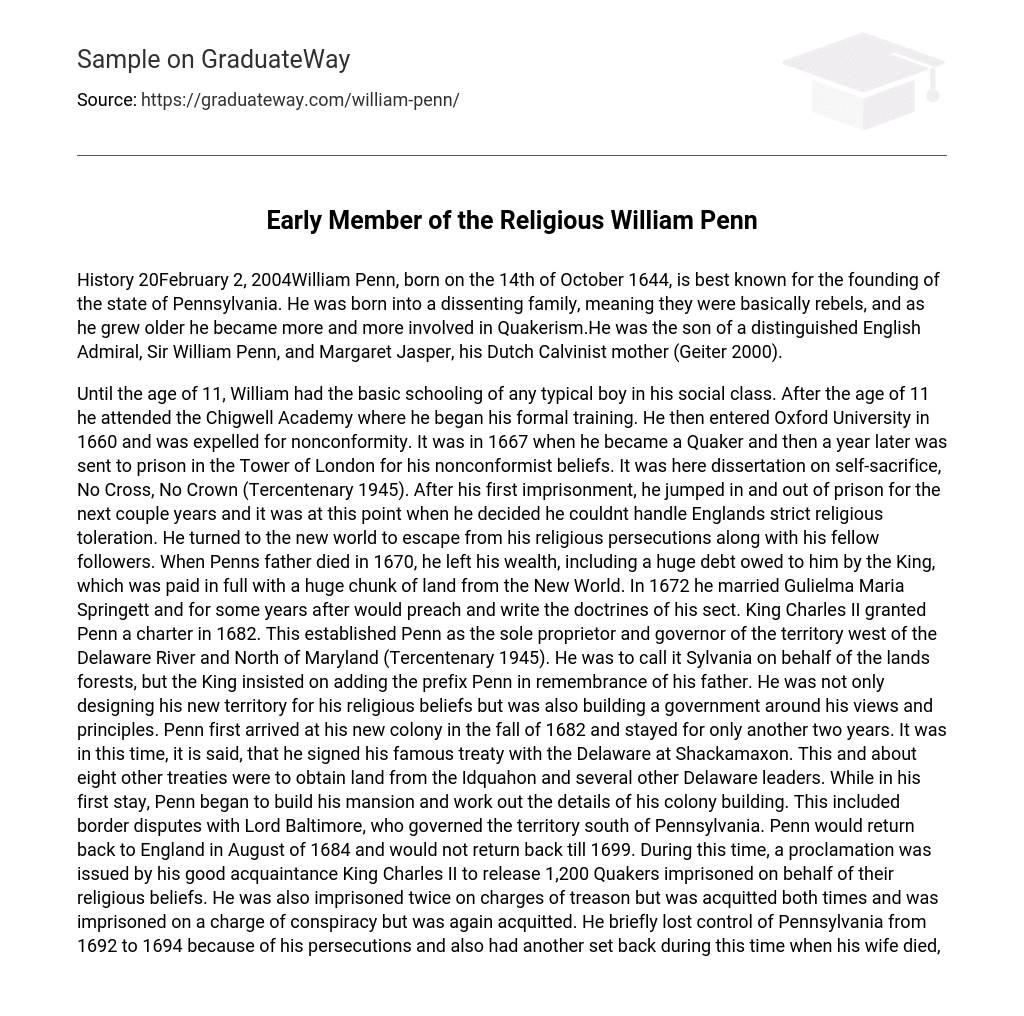William Penn, born on the 14th of October 1644, is best known for the founding of the state of Pennsylvania. He was born into a dissenting family, meaning they were basically rebels, and as he grew older he became more and more involved in Quakerism.He was the son of a distinguished English Admiral, Sir William Penn, and Margaret Jasper, his Dutch Calvinist mother (Geiter 2000).
Until the age of 11, William had the basic schooling of any typical boy in his social class. After the age of 11 he attended the Chigwell Academy where he began his formal training. He then entered Oxford University in 1660 and was expelled for nonconformity. It was in 1667 when he became a Quaker and then a year later was sent to prison in the Tower of London for his nonconformist beliefs. It was here dissertation on self-sacrifice, No Cross, No Crown (Tercentenary 1945).
After his first imprisonment, he jumped in and out of prison for the next couple years and it was at this point when he decided he couldnt handle Englands strict religious toleration. He turned to the new world to escape from his religious persecutions along with his fellow followers. When Penns father died in 1670, he left his wealth, including a huge debt owed to him by the King, which was paid in full with a huge chunk of land from the New World.
In 1672 he married Gulielma Maria Springett and for some years after would preach and write the doctrines of his sect. King Charles II granted Penn a charter in 1682. This established Penn as the sole proprietor and governor of the territory west of the Delaware River and North of Maryland (Tercentenary 1945). He was to call it Sylvania on behalf of the lands forests, but the King insisted on adding the prefix Penn in remembrance of his father. He was not only designing his new territory for his religious beliefs but was also building a government around his views and principles.
Penn first arrived at his new colony in the fall of 1682 and stayed for only another two years. It was in this time, it is said, that he signed his famous treaty with the Delaware at Shackamaxon. This and about eight other treaties were to obtain land from the Idquahon and several other Delaware leaders. While in his first stay, Penn began to build his mansion and work out the details of his colony building. This included border disputes with Lord Baltimore, who governed the territory south of Pennsylvania.
Penn would return back to England in August of 1684 and would not return back till 1699. During this time, a proclamation was issued by his good acquaintance King Charles II to release 1,200 Quakers imprisoned on behalf of their religious beliefs. He was also imprisoned twice on charges of treason but was acquitted both times and was imprisoned on a charge of conspiracy but was again acquitted. He briefly lost control of Pennsylvania from 1692 to 1694 because of his persecutions and also had another set back during this time when his wife died, yet he quickly rebounded from this and married a year and a half later to Hannah Callowhill (Tercentenary 1945).
He would return back to Pennsylvania in December of 1699. With his great success with the Indians, Penn signed a treaty in 1700 in which the Indians promised not to help any enemy of England and to only sell furs and skins to the inhabitants of the providence. Towards the end of 1701, Penn would sail back to England. It was at this time he found out that he was practically ruined by the foul play of his agent, Ford, with whom he had left the management of his affairs.
When Ford died, he left such bad and false claims to his son and widow that were very much pressed. Because of this, he allowed himself to be imprisoned in 1708 to avoid extortion. His family and friends would eventually help to get him released but not until it was too late to save his constitution that was greatly impaired (Tercentenary 1945).
William Penn died on May 30th, 1718 and left behind three sons by his second wife, Richard, John, and Thomas. The colony remained in control of the three until 1776 (Geiter 2000). William Penns statue still stands atop of Philadelphias city hall, once the tallest building in the nation, and looks over the Delaware River.
Works Cited
- Geiter, M. 2000. Profiles in Power: William Penn. England: Pearson Education Limited.
- The William Penn Tercentenary Committee, 1945. Remember William Penn. Harrisburg: The Bureau of Publications, Pennsylvania.





